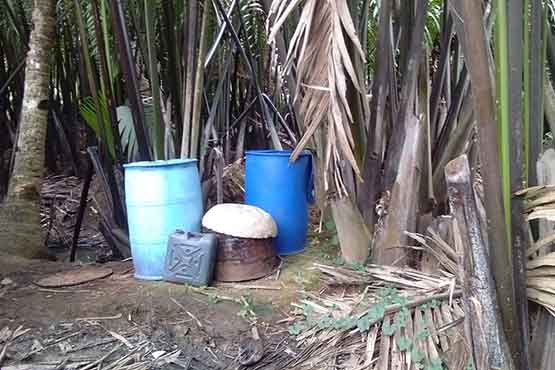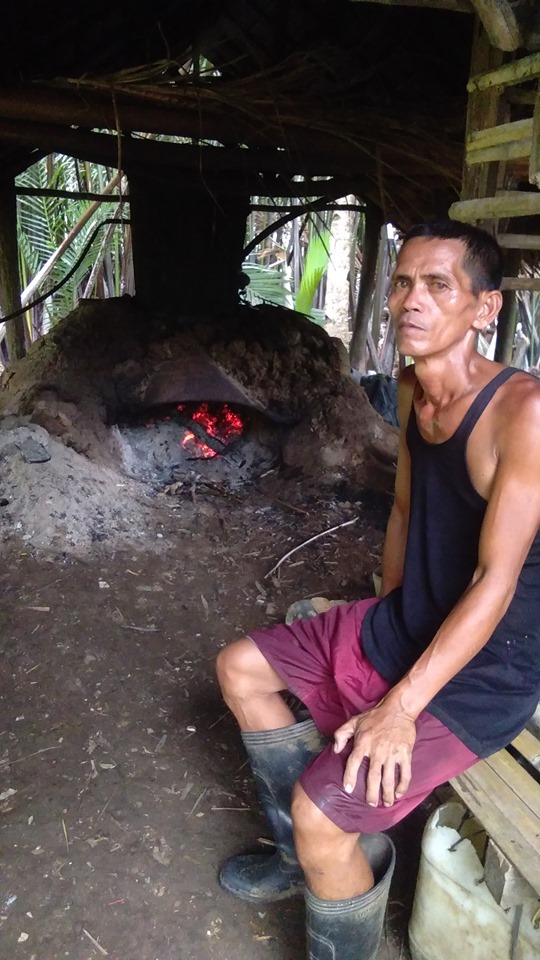There is more to nipa than the palms we see growing on the muddy banks in our estuaries, or the building materials made from it.
Recently, EcoWEB, through its partner Save Mindanao Volunteer, Inc., (SMVI), a partner based in the Caraga Region, worked together to produce ethyl alcohol from laksoy, a popular distilled alcoholic drink made from nipa sap extracted from its inflorescence or flower cluster. .
Some quick trivia about nipa
Before we go any further, it would be a good idea to learn some little things about our beloved nipa. The scientific name of nipa is nypa fruticans. It is also called nypa in other countries
Nipa is one of the most important economic crops in the Philippines. Before the popularity of fossil fuels, that is before World War II, Philippines was already producing industrial alcohol from nipa.
We all know some common uses of nipa. Its leaflets are used for making hats, baskets, raincoats, wrapping for suman and tobacco. Its midribs are used for making brooms and its petioles for fuel. The leaves were also traditionally used as sails for small water crafts.
Nipa is well-known as a good material for making our humble and popular bahay kubo. Before the arrival of galvanized iron sheets or GI sheets, nipa leaves were the main material used in thatching roofs. They are commonly called pawod or pawid. Pawod is also used for walls. A house with a roof of nipa makes the inside extra cool. That is why aside from its indigenous look, it is popular with tourists who want a more tropical feel of accommodation.
The Nipa sap extracted from its infloresence is used for making vinegar and laksoy, a distilled alcoholic drink popular in the CARAGA region in Mindanao.
The sap can also be made into sugar.
Nipa is also a good material for making low-fat flour with high fiber content.
Nipa is also popular as medicine. Its fresh leaves are used to treat ulcers. The juice of young shoots is mixed with coconut oil and used to treat herpes.
The roots and leaves are used for headaches and toothaches; the fermented sap diluted with water is used as eyewash in eyelid inflammations; its vinegar used for diabetes.
An account by Father Blanco in “The Philippine Flora” revealed nipa as a cure for centipede bites. Its partially dried leaves can also be placed over a sore, preventing the formation of pus.
Nipa is also a good source of food. Its young seeds are edible. The young flower stalks and seeds are a good source of water and food.
And in this time of pandemic, its sap was successfully made, locally, into ethyl alcohol that helps the front liners in their fight against the COVID-19 virus

What is nipa?
Nipa or mangrove palm is a tropical plant that thrives in brackish swamps and muddy banks throughout the Philippines and Southeast Asia. Its trunks grow beneath the ground and only the stalks grow upwards. It is considered native to the Philippines, many Asian countries, and the Oceana.
It was introduced to Western Africa, though it become an invasive species there and outcompetes and displaces other mangrove species in the area.
But in countries where it grows natively, nipa was effective as erosion control along coastal mudflats.
Ethyl alcohol from nipa
Ethyl alcohol, or ethanol is a colorless liquid and a principal ingredient in alcoholic beverages like beer, wine or brandy. It is water-soluble and because of that property, it is widely used in cosmetics and manufacture of food.
Producing ethyl alcohol from nipa is not a new idea, even before the coming of the Spaniards to the Philippines, there was a thriving business of alcohol production in Luzon. In the Annual Reports of the War Department in 1905, it detailed the liquor business in Luzon and the rectifying plants in Manila. Even Malaysia produced fuel from nipa that was used in automobiles. That was cut short with the popularity of fossil fuels. Studies about its potential as bio fuel abound in the Philippines.
In the CARAGA, nipa sap is turned into laksoy using crude and age-old distillers called laksoyan.
During the start of the pandemic, when ethyl alcohol was difficult to obtain, EcoWEB, through its COVID-19 information drive project funded by CORDAID, initiated the production of ethyl alcohol from nipa sap. This was made possible through the facilities of Joy Table Sauce, a local manufacturing company in Butuan owned by Engr. Roderico Cane. Engr. Cane was on the lookout in joining the fight against COVID-19. Through SMVI, the production process was arranged.
To get a good supply of laksoy, SMVI went as far as Surigao. It ordered an initial volume of 1000 liters of laksoy. Laksoy is the distilled nipa sap which is ready-to-drink. But laksoy has only around 30% alcohol. Joy Table Sauce further distilled the alcoholic drink to get the concentration of 70% as required to be used against the COVID-19 virus.
Fulfilling the laksoy order is the Cabugaw Mananguite Development Association (CAMADA) headed by its President, Welmario Dalanan of Cabugaw, Bacuag, Surigao del Norte.
Mr. Dalanan said their association produced around 140-160 liters of laksoy per day. On average, each farmer earns P500 to P600 per day.
But the pandemic’s liquor ban has considerably slowed down their sales. The order of 1000 liters of laksoy has helped them a lot, especially during this pandemic.
“Nalipay mi nga nakatabang niining sa COVID-19. Pwede diay ni himuon ug alcohol. Abi namo taman ra inom,” Mr. Dalanan said.”Unta magpadayon ni siya para matabangan ang panginabuhian sa mga manangite diri.”

Potential of Nipa for bio ethanol
Engr. Cane shared about the potential of nipa to meet biofuel needs of the country. He said biofuel from nipa sap could be used to fuel motors used in fisheries and agriculture. An hectare of nipa could easily give around 50 liters of ethanol per day. He estimated that there are not less than 3,000 hectares of nipa farms in the Surigao area. The CABI.org data sheet reported that there are around 8,000 hectares of nipa in the Philippines. If that can be harnessed, it will be a big help in easing our need for fossil fuels.
Nipa sap contains a high amount of ethanol compared to other biofuel feedstock. Below is a quick comparison among other biofuel sources:
Nipa 6,480- 10,224 L/hectare/year
Sweet potato 6,750-18,000 L/hectare/year
Coconut sap 5,000 L/ hectare/year
Sugarcane 3,3506,700 L/hectare/ year
Cassava 3,240-8,640 L/hectare/year
Corn 2,000 L/hectare/year
The above computation was done based on traditional management. The amount of alcohol from nipa is expected to increase up to 18,165 liter/hectare/year by modern management.
Ethanol from nipa sap also takes less time to produce compared to others sources.
Nipa can help in the fight against global warming and its effects
Another under-rated function of nipa palm is its ability to sequester carbon and acts as a carbon sink, meaning it can store more carbon than it can release.
We all know that atmospheric carbon has increased because of human activities. This results to various climactic changes including abnormal weather changes.
Studies proved that nipa palm, including other mangrove species are effective in trapping these greenhouse gases and in easing the effect of climate change.
Nipa also helps in stabilizing the soil, prevent coastal erosion, lessen the impact of rising sea level, and reduce the forces of waves arising from typhoons in coastal areas.
During the tsunami of 2004 that killed more than 216,000 people along the Indian Ocean communities, lives and villages in Thailand were saved by the spidery network of mangroves and nipa palm. It was only after the tsunami that people understand the importance of mangroves. They are now working on a project to plant more nipa and other mangrove species and to protect the existing ones. (Read that story here)
Nipa palm serves as the first line of defense against the impacts of tsunami, hurricanes, and cyclones in the coastal zones.
Malaysia now undergoes a big project in exploring the potential of nipa palm for ecosystem restoration and climate change mitigation, sustainable livelihoods and renewable energy.
One important thing to know is that nipa does not compete with other agricultural crops, thus you don’t have to burn down a forest to plant nipa. It propagates on its own giving a suitable habitat for many marine species.
Source of livelihood
For centuries, nipa palm provided livelihood to many Filipinos. Even before the coming of the Spaniards, the Filipinos have been making nipa wine. Though there was a monopoly in the distillation of nipa wine since 1712, the monopoly was lifted in 1862 and common people were free to trade and manufacture their own spirits. By the coming of the Americans, among the provinces that had extensive distillers were Pampanga, Pangasinan, Bulacan, and Tarlac.
Nipa wine making was also an old tradition in Surigao and Butuan. In the Report of the Director of the Philippine Weather Bureau, 1902, this nipa wine was called “tambacan” and was very popular in these areas.
In Thailand, people have been harvesting nipa sap from the same nipa thicket for 200 years without declining rates of production. Nipa provides permanent employment because harvesting cannot damage the tree.
In Sundarbans of Bangladesh, the mangrove area in the delta formed by the convergence of the Ganges Brahmaputra and Meghna Rivers in the Bay of Bengal, people depend on nipa palm for their livelihood. Around 80% of the houses here are made of nipa palm.
Looking forward
Nipa has a big potential in creating more livelihood opportunities for people living in the delta areas of our country. Looking into these potentials is the focus of EcoWEB as it develops programs that add worth to seemingly low-value crops like nipa.
This is one of the programs of EcoWEB: to promote sustainable resource (soil, water, forest) development and management technologies, endeavors for food security and productivity enhancements and to develop community-based social enterprises following value-chain approach as strategies for developing an inclusive sustainable local economy that would ensure benefits for the more vulnerable and marginalized.
The abaca project is one example.
EcoWEB hopes that the project it had started with producing ethyl alcohol from nipa sap will continue to address other similar important issues like global warming, climate change, and food security.
Focusing some efforts on nipa is a win-win-solution. It helps in improving the environment and providing livelihood for the people.
Do you think nipa can be another tree of life?


